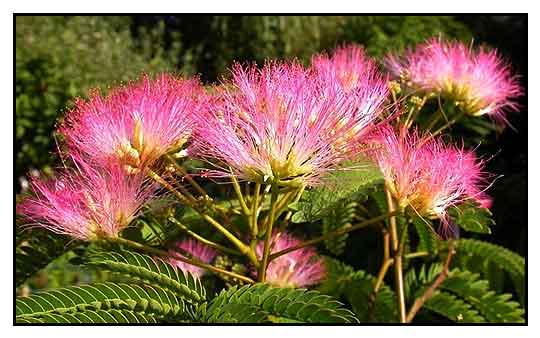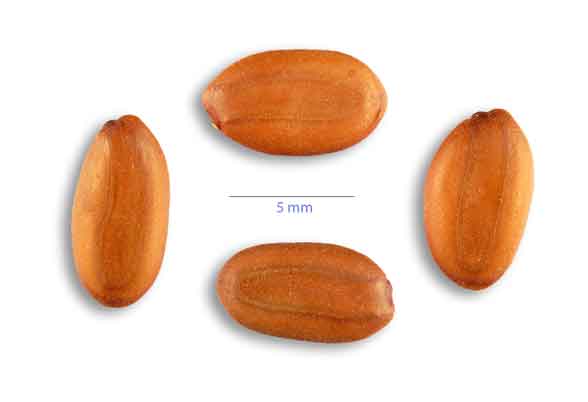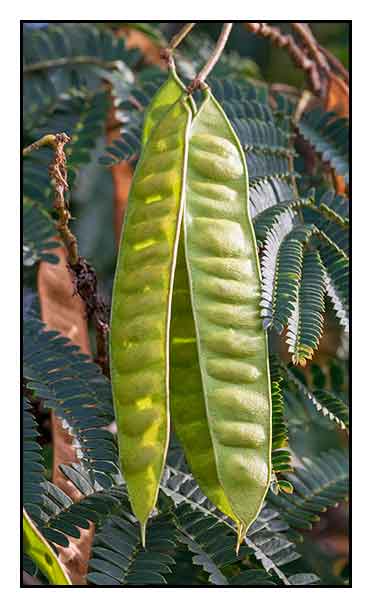 Gen info Gen info
- Albizia julibrissin was first introduced in Europe (particularly Florence, Italy) in 1745 from Constantinople (Istanbul, Turkey) by Filippo Degli Albizzi. It was first described by Antonio Durazzini, who dedicated the genus name to Albizzi.
- Species name "julibrissin" derives from the corresponding Persian name.
- The genus Albizia comprises approximately 150 species, mostly trees and shrubs native to tropical and subtropical regions of Asia and Africa.
(5)
Botany
Mimosa is a medium-sized deciduous tree that can grow to a height of 6 meters, usually multi-stemmed, a with a flat spreading crown, and a fast growth rate of about 25-50 centimeters per year. Bark is dark, greening gray, striped vertically as it gets older. Leaves are bi-pinnate, 20-45 centimeters long and 12 to 25 centimeters wide, divided into 6 to 12 pairs of pinnae, each with 20 to 30 pairs of leaflets. Leaflets are oblong, 1 to 1.5 centimeters long and 2 to 4 centimeters wide. Flowers are pink, showy, fragrant, and borne in dense fluffy clusters, grouped at the end of branches, resembling fluffy pin-cushions. Fruits are flat, straw-colored pods, about 15 centimeters in length, containing several brown oval-shaped seeds. (3)(5)
 Distribution Distribution
- Introduced.
- Ornamental cultivation., grown for its leaf texture and flowers.
-
In some places, considered a nuisance because of its invasive nature. It is highly invasive and can colonize areas in a short period of time.
Constituents
- Flowers yield a total of 25 types of aromatic components, with main aromatic constituents of Julibroside, trans-linalool oxide, linalool, isopentanol, α-ocimene, 2,2,4-tirmethylpentane, cyanidin-3-glucoside, among others. Foliage yielded an unknown quercetin derivative, hyperoside (quercetin-3-O-galactoside) and quercetin (quercetin-3-O-rhamnoside). (5)
- Bark has yielded
triterpenoid saponins (julibroside J29, julibroside J30, julibroside J31, and two phenolic glycosides (albibrissinosides A and B). (5)
- Leaves yielded a total flavonoid content of 35.14 mg/g.
(5)
- Study of stem bark yielded three new triterpenoid saponins, julibrosides A5-A7 (1-3), along with five known saponins (4-8). (10)
- Study of seeds yielded
an oil content and moisture of 10.50% and 1.56%, respectively. Free fatty acid, peroxide value, p-anisidine vale, saponification value, iodine value were 2.54%, 6.61 mequiv.O2/kg of oil, 1.98, 190.63 mg KOH/g and 111.33 g/100 g of oil, respectively. Dominant fatty acids in the oil were linoleic acid 58.58%, palmitic acid 13.86%, and oleic acid 10.47%. (see study below) (1)
 Toxicity concerns Toxicity concerns
- Reported toxicity from green or mature pods; seeds and wood.
- Toxin: Legume yields a neurotoxic alkaloid that can cause neurological effects. It is thought to as as a pyridoxine antagonist. The toxicity is seasonal, when green or mature pods are available to sheep, goats, dogs, or cattle. Toxicity becomes a greater concern when trees are present in parks and gardens where children play. (11)
- Signs of intoxication can occur within hours of ingestion: seizures, tremors, staggering and labored breathing. Toxic dose range is 10-15 g/kg; LD was ≥ 15g/kg.
(11)
- There was a report of A. julibrissin poisoning involving 3 children presenting with decrease levels of consciousness at the Nashhad Medical Toxicology Research Center. They progressed to coma, but eventually recovered without residual deficits.
(11)
Properties
- Requires irrigation once established.
- The tree drips with nectar, and is attractive to hummingbirds, honeybees and butterflies..
- Seeds have an impermeable coat and can remain dormant for years.
(3)
- It is moderately invasive, able to grow rapidly; sprouts can grove over 1 meter in a season, re-sprout after damage and seed prolifically. (4)
- Herb is sweet bitter in flavor.
- Pollen can be a source of hay fever. (11)
Parts used
Flowers, leaves, oil.
Uses
Edibility
- Young leaves are cooked; used as potherb. (16)
- Dried leaves used as tea substitute.(16)
- Flowers are cooked, eaten as vegetable.(16)
Folkloric
- A valued Chinese botanical for relieving anxiety, stress, and depression. Referred to by some Chinese herbalist as the "herbal prozac."
- Its extract and essential oil are widely used for dysphoria-induced wakefulness, depression, forgetfulness, and dreaminess. (5)
- It is a constituent in the well known Chinese medicine for insomnia, together with Suan-zao-reng-tang and P. multiforme. (5)
- In Taiwan, it is the most prescribed herbal medicine for insomnia.
(6)
Others
- Fodder: Seeds are used as food for livestock and by wildlife.
- Agrofrestry: Used as reclamation plant.
Studies
• Sedative / Antidepressant: Study on mice drenched with decoction significantly showed reduction in spontaneous activity and passive activity. Effects have included tranquilization, regulating qi to whet appetite, dispersing wind to improve eyesight and promoting blood circulation. (5)
• Anti-Inflammatory / Leaves: Study of ethanol and hydroalcoholic extracts of leaves of Albizia julibrissin showed significant anti-inflammatory activity in HRBC membrane stabilization method. Percentage inhibition of membrane lysis by ethanol extract was 60.87% (1000 µg/ml) compared to standard diclofenac sodium at 69.56% (50 µg/ml). (6)
• Amelioration of Memory Loss Induced by Insomnia: Study evaluated the effect of A. julibrissin on sleep deprivation-induced memory loss in a Drosophilia model. Results showed A. julibrissin ameliorated a 3-hour memory loss but not 1-hour memory or instant learning. Findings might have application in anticipated short-term sleep disturbance. (7)
• Learning and Memory Enhancing Activity / Essential Oil: Study evaluated the learning and memory enhancing activity of A. julibrissin against amnesia induced by scopolamine in young mice. Piracetam was used as standard. Anticholinesterase activity was evaluated. Administration of essential oil prevented scopolamine induced experimental amnesia and may have great potential in memory deficits. (8)
• Ultrasonic-Surfactant Extraction of Flavonoids / Flowers: Study reports on the methodology for extraction of total flavonoids from Albizia julibrissin flowers by combing surfactant with ultrasonic technology. (9)
• Effect on Growth and Brain Monoamine Neurotransmitters: Study investigated the effects of A. julibrissin on growth and brain neurotransmitters in chronic stressed rats. Brain tissue was analyzed for content of homovanillic acid (HVA), norepinephrine (NE), dopamine (DA) and 5-hydroxytryptamine (5-HT) .Results suggest A. julibrissin alleviates growth inhibition cause by stress and regulates the levels of brain monoamine neurotransmitters in stressed rats. (12)
• Inhibition of Tumor Growth / Antiangiogenesis: Study investigated the in-vivo and in-vitro anti-angiogenesis effect of of A. julibrissin extract. The extract remarkably suppressed basic fibroblast growth factor-induced proliferation and migration and tube formation of HMEC-1. In -vivo, extract significantly inhibited tumor-induced angiogenesis and tumor growth in an intradermal inoculation mouse model. Results suggest potential as a potent anti-tumor drug, which exerts an anti-tumor effect through anti-angiogenic mechanism. (13)
• Seed Oil: Analytical study of seed of Albizia julibrissin showed it is a promising oilseed crop, which can be used for making soap, hair shampoo, and UV protectors. Its high level of unsaturated fatty acids adds to a desirable nutritional profile. (see constituents above) (14)
• Effect on Low-Density Lipoprotein Oxidation: Study reports on the extraction of flavonoids from A. julibrissin biomass. Foliage, flower, and whole plant extracts were tested for potential to inhibit LDL oxidization Highest inhibition was obtained with foliage water extracts, which were standardized at 2.5 µM of flavonoids. Water extracts were not toxic to Vero 76 cells. (15)
• Total Saponins / Inhibition of Vascular endothelial Growth Factor Medicate Angiogenesis: Study evaluated the anti-tumor and anti-angiogenic effects of total saponins from A. julibrissin. Results suggest the total saponins from A. julibrissin has potential an antiangiogenic agent that targets the VEGF/VEGER2 signaling pathway, and inhibits tumor-induced angiogenesis. (17)
Availability
- Wild-crafted.
- Herbal syrups in the cybermarket.
|

![]()



 Gen info
Gen info Distribution
Distribution Toxicity concerns
Toxicity concerns